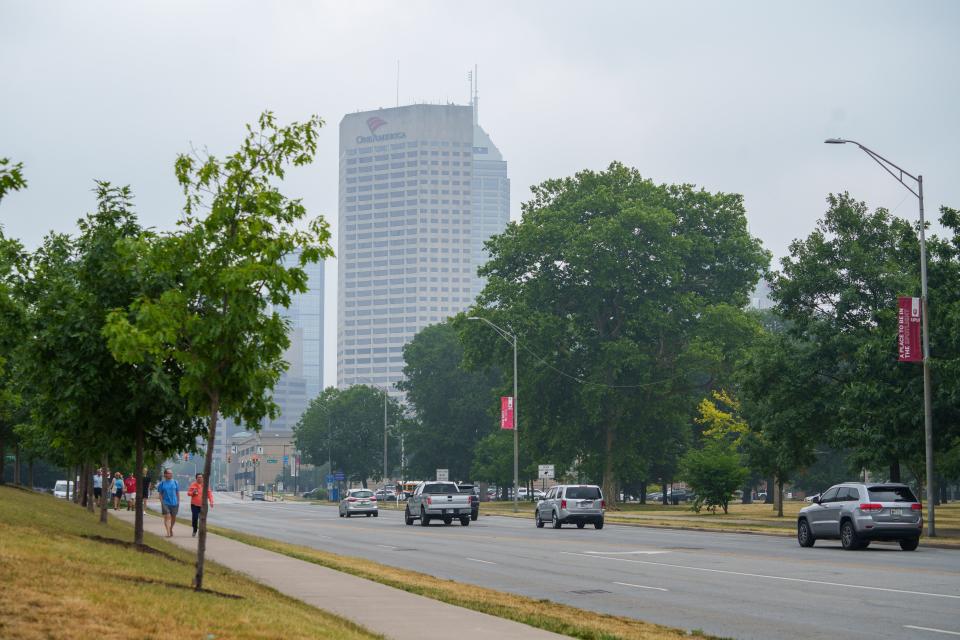After a half century, an amicable divorce for IUPUI
- Oops!Something went wrong.Please try again later.
- Oops!Something went wrong.Please try again later.
For the past half-century, the state’s two Big 10 universities shared the Indianapolis market with a Frankenstein approach that yielded “IUPUI.”
Last month, Indiana and Purdue universities participated in a cordial divorce, with the two universities going their separate ways, albeit while preparing to live across the street from each other (better for the kids).
Former Purdue President Mitch Daniels credits IU President Pamela Whitten for creating this new paradigm.
“I had thought for a very long time, even before I got to Purdue, there might be some better configuration of the campus downtown than what we had,” Daniels explained from his office at the Liberty Fund in Carmel. “It served us well, but it was a treaty at the inception.”
That occurred in 1969 when, at the behest of new Indianapolis Mayor Richard Lugar, a new urban university was forged, albeit with the two universities protecting turf and legacy. Daniels joined the Lugar administration in 1971. “I was close enough to hear the stories. The original idea that Mayor Lugar had was an urban university of Indianapolis,” Daniels explained. “Purdue and IU were not interested in that new rival. So out of that, and I always described it as a treaty, they gave birth to IUPUI.

“But I had thought for a long time, and I was hardly the only one, there might be a better way forward. There is also a lot of interest in the central Indiana community to a genuine, R-1 tech presence, which IUPUI did not represent. There was some good quality faculty and some research was happening there, but not the kind the city needed. The Battelle Study found us to be the biggest city in the nation that didn’t have a genuine R1 university.“
That Battelle report released in 2015 observed: “For continued success, Indianapolis needs to take more strategic advantage of the strong concentration of talent in its urban core, leading to a nationally competitive range of opportunities for regional growth and innovation in life sciences, information technology, agricultural innovation, advanced manufacturing, and other ‘advanced industries.’”
BioCrossroads CEO David L. Johnson added, “Our ability to compete on a global level requires two factors — talent and innovation. Talent begets innovation, but it also needs a physical hub to thrive — and we really don’t have that place here yet.”
Daniels took the helm at Purdue in 2013 after two terms as Indiana governor.
“I had tried the idea on the IU administration more than once and there was just not interest,” Daniels said. “But when Pam Whitten was chosen, we spoke right away and I congratulated her. We got together very shortly after she had been named and after the pleasantries, the first thing I asked her was, ‘Would you be willing to consider doing something different in Indianapolis where we have this thing called IUPUI?’ And Pam said, as many had before her, ‘Yeah, what the heck is that?’”
“It was always confusing to people,” Daniels said of the joint campus that prompted the early derisive phonic “OoeyPooey.” “I give her full credit. She was open to the idea and then her board was open to the idea and off we went.”
So this was two years in the making?
“Yes,” Daniels responded. “Tons of back and forth, trying to make certain what we came up with was beneficial to both schools and to the community. At Purdue, we opted … this is not a regional campus. It will be fully a part of Purdue University. The faculty here will be fully part of the engineering, computer science, perhaps other faculties up there. Their work will be integrated. I’m very hopeful it will give us a new option for students. We’ve been turning away some tremendously qualified applicants at Purdue, principally from other states, even after 30% growth.
“I think IU will have a clearer definition around health care and so forth, as is their focus,” Daniels said. “I’m sure they’ll do some imaginative things, too, that were just unlikely to happen under the old structure.”
Gov. Eric Holcomb told me in June that Whitten and the IU Board of Trustees decision to rethink the Indy campus was nothing short of “courageous.”
When this amicable divorce was signed in June, both current university presidents were ecstatic.
“IU’s goal is nothing short of building one of the nation’s pre-eminent urban research universities, one defined by students transformed, discoveries made and communities strengthened,” Whitten said.
Purdue President Mung Chiang, added, “Today’s announcement launches transformative growth for our state’s land grant university. New opportunities for Purdue University in Indianapolis are limitless.”
Daniels called it a “great brain gain of possibility” in a state that has been battling “brain drain” for years as a significant percentage of IU and Purdue graduates got their diplomas and headed for the coasts.
“Imagine some outstanding electrical engineer from Oregon who comes down and works in one of the IT startup companies here, or works for Salesforce or Lilly’s IT department to capture that talent in the future,” Daniels explained.
Brian Howey is managing editor of Howey Politics Indiana/State Affairs. Find Howey on Facebook and Twitter @hwypol.
This article originally appeared on Evansville Courier & Press: Howey: After a half century, an amicable divorce for IUPUI

